-
Posts
6,486 -
Joined
-
Last visited
-
Days Won
9
Content Type
Profiles
Forums
Blogs
Gallery
Events
Store
Posts posted by Brian Wolfe
-
-
There are two factors to the ribbons to clear up what I wrote above. Some ribbons are replaced with a long keychain ribbon cut down to size to fit the medal or an unknown piece of cloth. Others are manufactured with the wrong ribbon to sell for souvenirs.
These types of medals are not only coming out of Iraq from the occuping forces. These medals are mailed to dealers in America who are making a great deal of money. They are selling the medals for $50-$100 dollars after they have bought a large shippment from dealers in Iraq for a few bucks. These medals are then bought from the American dealers by people that think the have discovered a new type of Iraqi Medal or Order. The collector who lacks the knowledge in the Iraqi ODM, which are growing in numbers. This is due to the vast market all over the web with large numbers of Iraqi medals to purches.
Thank you so much for your views and insight
Lorenzo
Hi Lorenzo,
Thanks for the additional information. Often I read on the forum that this or that is a fake or a reproduction with nothing to back up such a statement. Perhaps it's old age but I no longer take such opinions as Gospel as too often they are based on pure opinion without any supporting background. As to Iraqi medals, I know nothing and as you have advised I will stay a long ways away from them.
Cheers
Brian
0 -
Iraqi Bravery Medal Fake ribbon.........

Just to be clear, what is it you mean by a fake ribbon?
Are these ribbons manufactured to "look like" the real thing and to be passed off as such, or do you mean an incorrect ribbon as technically that would not necessarily constitute a fake.
Thanks in advance for clairifying this question.
Regards
Brian
0 -
Hi Hauptman,
I think it's nice as well. Here's a photo of the one I purchased earlier this year from a fellow GMIC member.
Regards
Brian
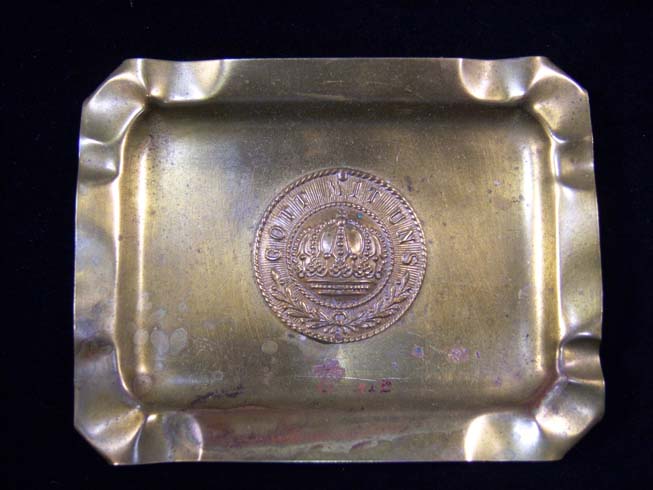 0
0 -
It looks quite nice!
Well done.
Thanks
Brian
0 -
Brian,
Nice save! I have always felt the paper documents are somewhat more rare than the medals. Very often the paper just does not last, or once tattered eventually gets thrown out ? what a shame.
The Scrolls are scarce enough, but I have never seen the document which was sent with the Scroll.
Cheers,
Gary
Hi Gary,
I agree with you. They don't pass the test of time like a medal. This is the first time I'v seen the document for the scroll as well. That was what caught my attention and only then did I realize that these papers all belonged to the same fellow.
Regards
Brian
0 -
Thats spot on Brian well done, I'm sure you'll soon make your funds up

BANTAM BATTALIONS (information taken from the www)
? 85. Mr. WATT asked the Under-Secretary of State for War whether the raising of a battalion of less height than the regulations permit, namely, 5 feet 3 inches, has been sanctioned for several towns in England, including Manchester, Leeds, Birkenhead and Bury; whether this permission has been refused to the large Scottish towns, including Glasgow and Edinburgh; if so, will he say why this distinction has been made; and is he now prepared to put the two countries on an equal basis so far as the raising of bantam battalions is concerned?
Early in the war, when hundreds of thousands of young men were rushing to enlist, there were tens of thousands who found their patriotic ambitions thwarted by regulations. Age was probably the main one, but this was easily circumvented, and there are many stories of youngsters who, having been refused when they gave their true age, simply went to the end of the queue and added a couple of years when their turn came round again. It was more difficult, though to overcome the Army's minimum height, which was 5 feet 3 inches. No matter how fit, strong or willing a man might be, there was no room for him in the army if he could not meet this height requirement.
It took time, but eventually the authorities came to realise that there was a large number of would-be soldiers, keen and eager to serve, and that there were big hearts beating within their small frames. Special Battalions - which became known as Bantam Battalions - were formed and at last, there was a place for these small men who wanted to prove that they could be as good soldiers as any of their taller brothers.
Geoff
Hi Geoff,
Thanks for the information. I have not had the time to research the term "Bantam", though I suspected it had to do with shorter soldiers. It's generally known that it's not the big fellow you have to be careful of, it's the little guy. After all as they say, "It's not the dog in the fight that counts, it's the fight in the dog." Only a pint-size fellow like me would say that of course.

Cheers

Brian
0 -
Well done, it's good that these things stay together. You must have asked the dealer about the whereabouts of the medals? Any idea how the dealer came by the plaque & documents?
Hi Leigh,
The Antiques Malls rent out stalls and the vendor supplies his own locked cases for display. There are attendants who will open the cases for you to take a closer look and perhaps purchase the item. The company who owns the two malls in our area will not give out the names of the vendors. I have left notes for them in their "mail boxes" but becuase this is behind the sales counter the company tells you they will put the note in the box but I doubt they do so as I have never gotten a call from any vendor. Some vendors will place business cards in the cases but most do not. All I can do is to keep checking and hope I either run into the vendor some day when he (I found out the vendor was a man) is stocking his cases or perhaps I'll see the medals for sale. It is all very frustrating.
Regards
Brian
0 -
The last document dated in 1922 states the medals he won. Notice that this is one of those "one-form-fits-all" government forms.
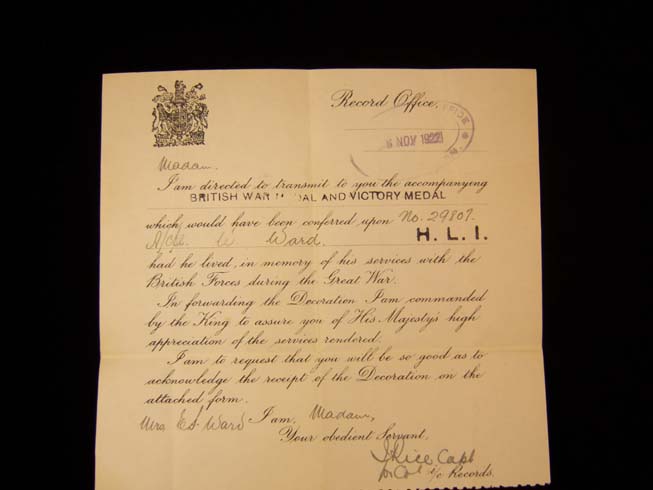 0
0 -
This is the document that came with the Memorial Scroll.
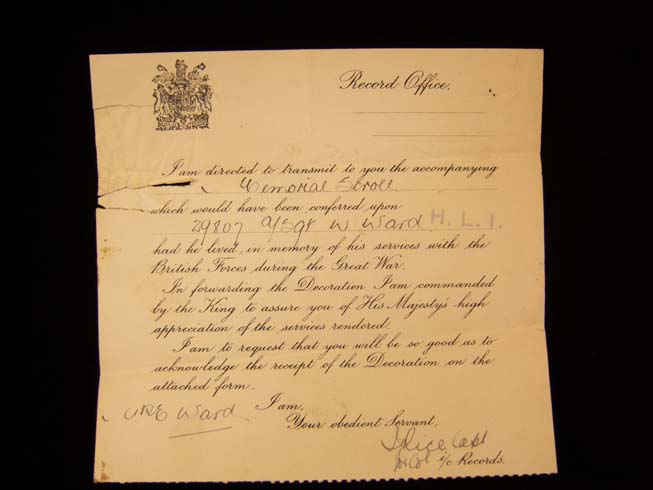 0
0 -
This is the form letter the family received regarding the loss of their loved one. It is not named but it came with the rest of the documents and seems to be of the same age and shows the same wear as the other papers.
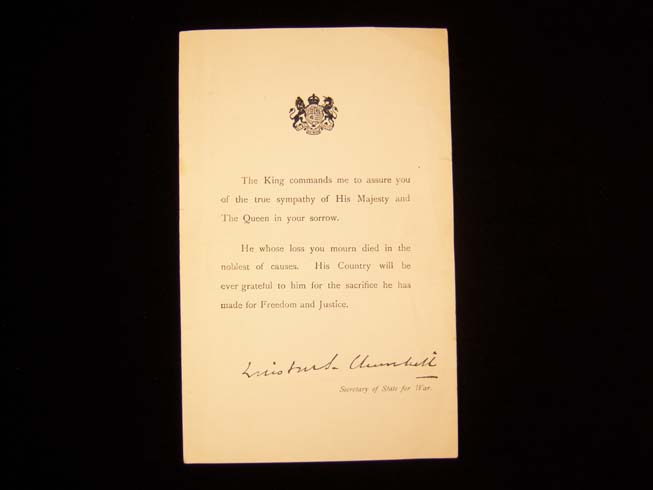 0
0 -
Here is the document that changes his status from Missing to Deceased. I understand that these documents were important if the family was to receive any pension benifits due to the loss of their family member.
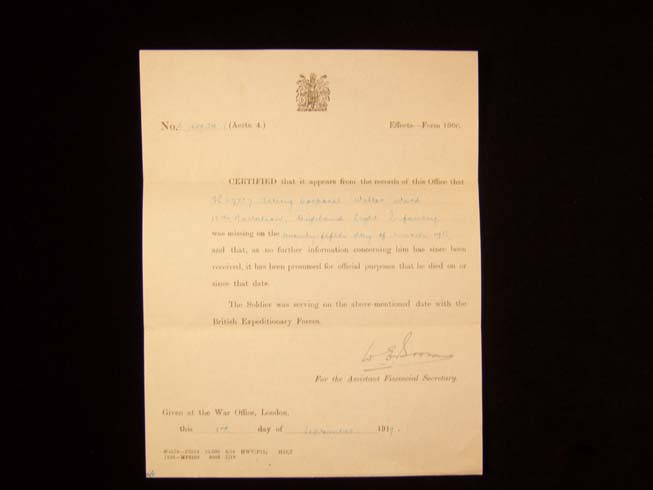 0
0 -
Hello Everyone,
While paying a visit to a local antiques mall I noticed a Memorial Plaque Scroll for sale. It had been folded into quarters and was priced about four times too high considering it had been folded. I put it back and kept looking at the different documents this fellow had on sale. They were all for sale separately.

Even though they were all priced well beyond anything near a reasonable price I started to think that the chances were that if any of these pieces sold it would be to different collectors. I felt I had to keep them together so I dug deeply into my collecting fund and the next thing I knew I was the new caretaker of the set of documents to 29807 Cpl. Walter Ward of the Highland Light Infanrty who died on 25 March, 1918 near Hardecourt-aux Bois (Somme).
Some research into the history of his unit and the days surrounding his death are as follows:
The 18th (Service) Battalion (4th Glasgow) was formed in Glasgow on 26 February 1915, as a Bantam Bn., by the Lord Provost and City. June 15th: Attached to 106th Brigade, 35th Division. In August 1917 the Corps Calvary Regiment's squadrons were re-roled as infantry and sent for infantry training at Etaples. The Regiment would form the majority of the 18th Battalion of the Highland Light Infantry. On 23 September 1917 the dismounted Glasgow Yeomanary amalgamated and became the 18th (Royal Glasgow Yeomanary) Bn.
1918 found the 18th near Hardecourt-aux Bois (Somme).
The 12th and 18th H.L.I. went into action at Hardecourt, after two nights on the train and a seventeen mile march. In the early hours of 21st March 1918 the Germans threw 60 divisions into a final push action. After three days of heavy fighting the Germans had advanced to a line running from Delville Wood through the eastern edge of Hardecourt to Curlu on the river Somme. The enemy began a heavy barrage at 07:45 on the 25th March and then followed this with a strong frontal attack. An outpost was overrun and part of Faviere Wood was taken by the men of the German 199th Division.
A defensive position had been formed between Hardecourt and the Somme and on it, during March 24 and 25, the 35th Division put up[ a magnificient fight against five German Divisions.
29807 Corporal Walter Ward was listed as missing in action 25 March 1918 and on 3rd September, 1919 he was declared dead by the War Office according to the documents in this group.
Thanks for reading my post and looking at the documents that follow.
Regards
Brian
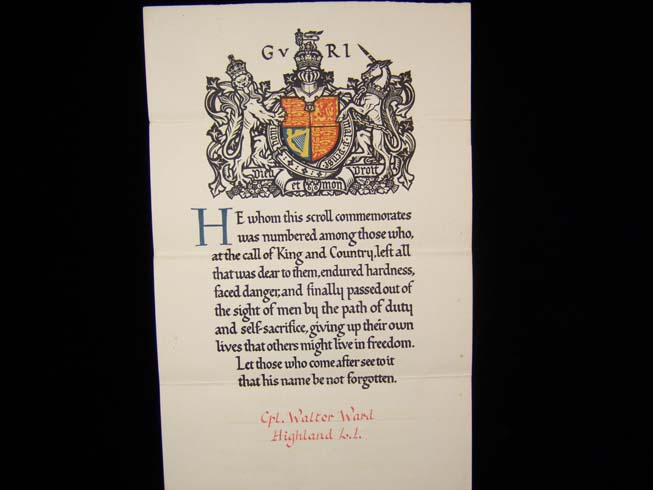 0
0 -
Here's the reverse. I had to leave the white adhesive on the back of the Inpedendence Medal ribbon if I wanted to use the original ribbons. It worked out that this allowed the best ribbon surface to show.
All in all I am quite happy with my new addition.
I'm sure many would find this little group quite mundane but I got to do some research into the correct order of display, ribbon mounting "correctness" and now have a new attributed group for my collection using what I think could be original ribbons.
Regards
Brian
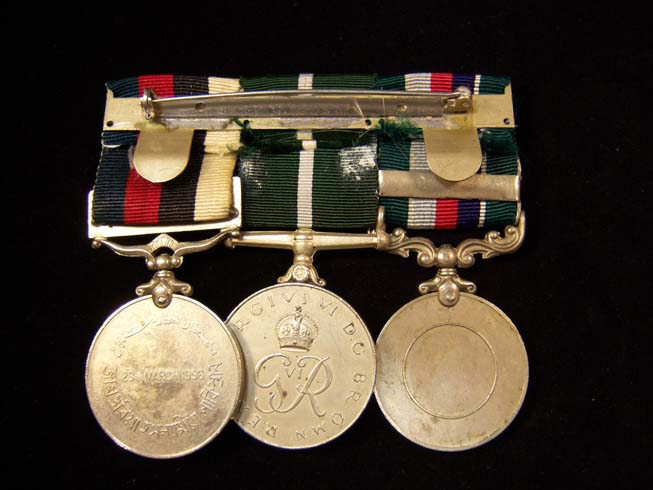 0
0 -
In reverse order?
Hi Ulsterman,
Well, partially. The order was out of whack, it should have been
Tamgha-i-Diffa (Medal of Service) Kashmir 1948 clasp. At least this one was correct.

Pakistan Independence Medal
Tamgha-i-Jamhuria 1375/Repiblic Medal 1956
There was a problem with the ribbons as well, they were put up backwards! The Independence Medal looked correct but probably only because it looks the same one way or the other. This probably happened due to the confusion caused by not "thinking in reverse" when you are sewing the ribbons to the medal bar. I almost repeated the mistake on the first medal myself. I've included a photo of the corrected mount. I used the same ribbons, even though I found enough spare ribbons in my surplus drawer, because I though that if these are original to the group I'd like to keep them with their medals. I turned the ribbons inside out after removing as much white glue as possible.
The last error was the Independence Medal was mounted with the reverse side showing. The Pakistan national flag should always be the obverse with GvR and crown as the reverse. This is another reason I think this was an error due to not thinking in reverse. The other two medals are on swivel mounts so they too could have been put up in reverse originally.
Now I am happy to say that the subject survived surgery and can take its place in the collection.

Regards
Brian
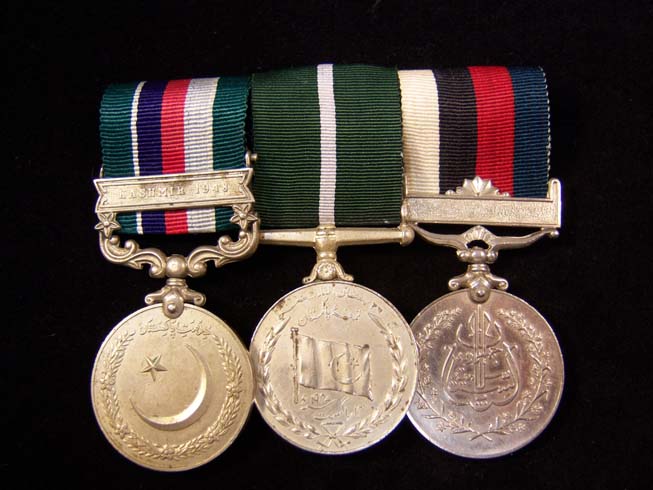 0
0 -
What a great job of the mounting, plus the supporting docments and other items makes this a museum quality grouping.
Well done.
Cheers


Brian
0 -
Here is the back of the group. Notice that I didn't use the term "reverse"? Hmmm a possible clue there.

The white goop is a rubber-like substance that I believe to be an adhesive that was probably used to glue the group to a display board at one time or another. It is still rubbery and I could remove most of it but I'll probably put new ribbons on the group at a later date. I intend to leave it as a swing mount as that is how it arrived. Other than that there are a lot of changes to be made before this group can join the collection.
So, what errors do you see?
Cheers
Brian
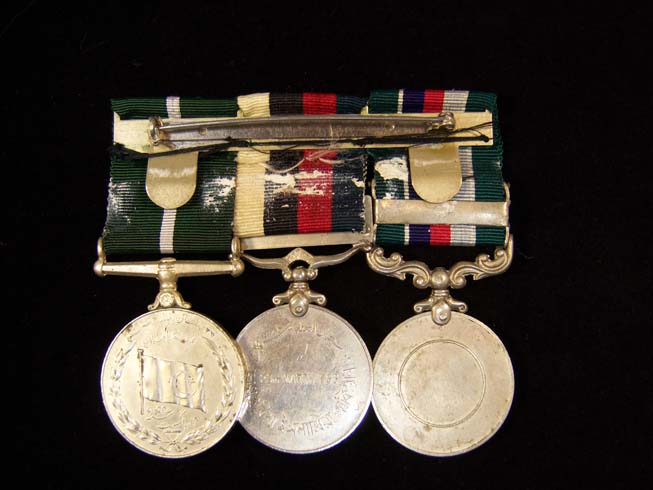 0
0 -
Hello Everyone,
I purchased this group, in part, because there were so many mistakes in the mount that I couldn't resist. As far as whether it is an authentic group or not is always in question with Pakistan groups especially when none of the medals are named. In this case the Independence Medal is named. Take a look and see if you can spot the errors, there's lots of them. The nighmare is not restricted to the front of the group, wait until you see the back.
The group is named (Independence Medal only is named) to,
3835031 SEPOY DHUMAN KHAN, 16 PB.R.
The medals are (from your left to right)
Tamgha-i-Diffa Medal/Medal of Service, Kashmir 1948 clasp (unnamed)
Tamgha-i-Jamhuria 1375/Republic Medal 1956 (unnamed)
Pakistan Independence Medal (named)
Cheers
Brian
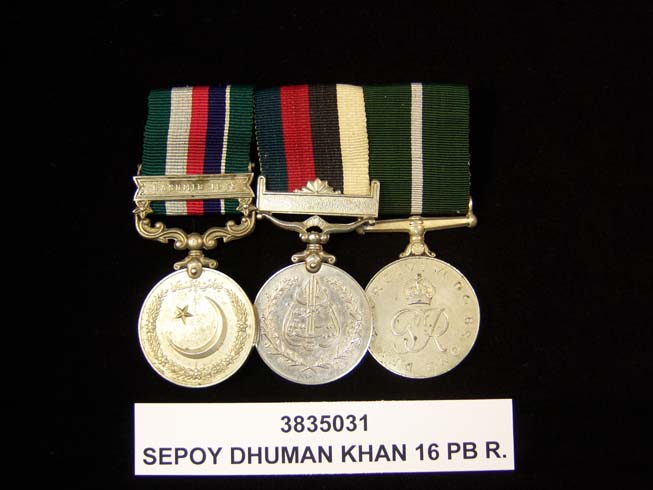 0
0 -
Hello Everyone,
Here's a group of 5 that I just finished court mounting. The group came complete with the shoulder titles and the stars, it also shows a nice progression through the ranks which is one of the things I liked about this group.
The medals were awarded to,
3342533/JC-71290 CHM/N-SUB/SUB. SURJIT SINGH, SIKH R.
The medals are as follows,
General Service Medal, NEFA 1962 clasp JC-71290 SUB SURJIT SINGH, SHKH R.
Pachimi Star JC-71290 N-SUB SURJIT SINGH, SIKH R.
Raksha Medal 3342533 N-SUB SARJIT SINGH, SIKH R.
Sangram Medal Unnamed
9 Year Long Service Medal 3342533 CHM SARJIT SINGH, SIKH R.
There seems to have been a problem with the spelling of Surjit or Sarjit when the medals were originally named. I have made out my display card as Surjit as that was the spelling on the General Service Medal and the Pachimi Star, given that the star was awarded for service in combat. I may be wrong on the proper spelling so if anyone has a comment it would be appreciated.
I hope you like my newest court mount.
Regards
Brian
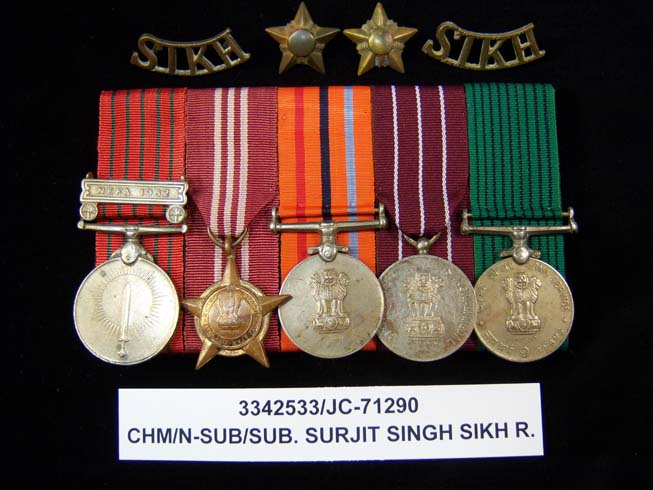 0
0 -
I read that you collect medals and I would like to get with you to show you quite a few WW1 German medals that I would like to sell. If you are interested, you can contact me and I will send you pics of all of them (around 20) for your assessment and consideration. Thank you.
Lloyd(Scorpitarious)
PM sent.
Cheers
Brian
0 -
That is just incredible!

I could not have wished for more information than that.
Thanks to all who lent their knowledge.
Cheers

Brian
0 -
The date on the post card should indicate a mark IV or V ,british WW1 tank, female and male versions depended on armourment.
You need to view the rear to get exact date as early one had a wheel to back ,and later were wider and then longer !!
steve
Hi Steve,
For whatever reason there is no date on the postcard.
I know it's not the best photo, it's my first tank photo in my collection.
Regards
Brian
0 -
Brian,
Not really much to work from, If you dont mind me using your photo i'll ask on the landships WWI forum for you.
Regards Eddie.
Of course you're more than welcome to use the photo.
Many thanks for your help.
Brian
0 -
They were ....towable.... u-hem....

Chris,
DON'T TELL ME THAT!!!!!

Actually this is my wife's fear ever since I visited our local museum and found out they have more artillery pieces than they have funds to restore and room to display. Next stop? The Auto Supply store for a trailer hitch!

Cheers
Brian
0 -
Hello Everyone,
I purchased this photo postcard today of a WW I "Tank In Action" (the postcard's title). This is a Canadian Official postcard printed in the U.K. with no date. The finish on the postcard is glossy and is starting to crack with age. I've tried to photograph it as best as possible to keep the lighting from showing too many cracks.
I've looked at several photos but as soon as one looked like a match the next one looked as good!

Can anyone identify the tank in the photo? I know there is not much detail but perhaps a trained eye can pick up enough detail for an I.D.
As always your help is greatly appreciated.
Regards
Brian
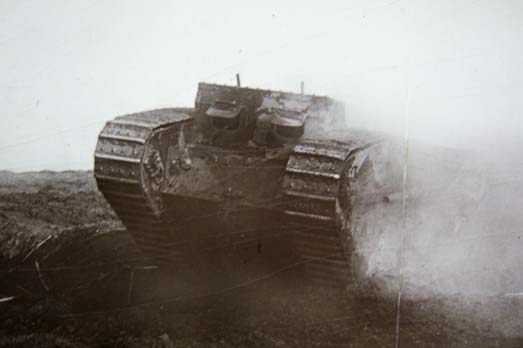 0
0




British Empire Medal found in the Sudan
in Middle East & Arab States
Posted
An excellent find, congratulatios.
Brian